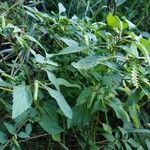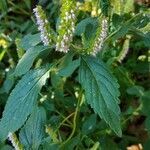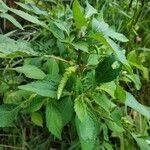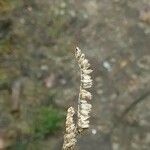Herbs erect, 30-50 cm tall. Stems glabrous or pilose, stramineous, purple-brown with age. Petiole 0.5-3.5 cm, narrowly winged; leaf blade ovate to elliptic-lanceolate, 3-9 × 1-4 cm, sparsely minutely hispid, adaxially sparsely resinous glandular, base cuneate decurrent, margin serrate, apex acuminate. Spikes 2-7 × to 1.3 cm, secund; verticillasters many flowered; bracts broadly ovate to oblate, ca. 4 × 4 mm, subglabrous to puberulent, sparsely resinous glandular abaxially, glabrous adaxially, ciliate or ciliolate, apical mucro to 2 mm. Pedicel ca. 1.2 mm, subglabrous, densely white pubescent. Calyx ca. 1.5 mm, pilose, sparsely glandular outside, glabrous inside; teeth triangular, anterior longer, needlelike, ciliate. Corolla purplish, ca. 4.5 mm, villous outside, sparsely glandular on posterior side; throat pilose, ca. 1.2 mm wide; upper lip emarginate; middle lobe of lower lip semicircular, lateral lobes arcuate, shorter than middle lobe. Anthers purple-black. Style included. Nutlets yellow-brown, oblong, ca. 1 mm. Fl. Jul-Oct, fr. Oct-Jan.
More
Branching annual 3–10 dm; lvs petioled, ovate to lanceolate, 3–7 cm, acute or short-acuminate, crenate-serrate, tapering to the base; spikes 2–5 cm; bracts rotund, 3 mm, cuspidate, ciliate, closely imbricate, each subtending 2 or 3 pale blue fls 4 mm; cor villous around the lips. Native of Asia, established in moist soil from Que. to N.Y. and N.J., and sometimes inland to Wis. July–Sept.
An erect herb. It grows to 60 cm high. The leaves have long stalks. The leaves are 2-8.5 cm long by 0.8-2.5 cm wide. They are oval to sword shaped. They have teeth along the edge. Underneath there are gland dots. The flowers are purple. They occur in flat spikes.
Roadsides, old fields etc in Eastern N. America. Grassy areas in mountains in Korea. Hills, waste areas, sunny terraces, riverbanks, forests; at elevations from near sea level to 3,400 metres.
More
Roadsides, old fields etc in Eastern N. America. Grassy areas in mountains in Korea. Hills, waste areas, sunny terraces, riverbanks, forests; at elevations from near sea level to 3,400 metres.
It is a cool temperate plant. In Nepal plants grow from 1500-3400 m altitude. In China it grows in waste areas and sunny terraces. It suits plant hardiness zone 5. In Yunnan.




